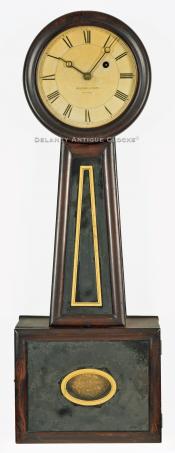Howard & Davis Model No. 5-Square Bottom wall clock. Boston, Massachusetts. II-31.
The Model No. 5 Square bottom wall clock is pictured in the 1858 E. Howard clock catalog. This model was originally marketed for use in "Dining Rooms, Offices, and small apartments." Both Howard & Davis and later the E. Howard Clock Company manufactured this model. The vast majority of the examples seen today are signed by the Howard & Davis firm. It can be challenging to find an example of this form signed by the E. Howard Clock Co.
This Model No. 5-Square bottom is considered unusual because the bottom section of the case is designed with a square box compared to the more prevalent version, which features rounded sides. In comparison, a relatively small number of these square bottom clocks were originally produced. The Model No. 5 is the smallest example of five separate banjo models that both firms manufactured. This case measures 29 inches long, 10.25 inches wide in the lower box, and just under 4 inches deep. The dial is approximately 7 inches in diameter. The other four banjo models that were offered in the catalogs are constructed on a graduating scale. The largest of the five individual models is the No. 1 Regulator. This regulator is approximately 50 inches long, 20 inches wide across the lower box, and features a 12-inch diameter dial. All of the models are traditionally constructed in cherry wood and grained with ink to simulate the vibrant grain pattern exhibited in rosewood.
The movement is made of brass and is of excellent quality. This movement is not die-stamped. Many of the early Howard & Davis clocks were not. It features a recoil escapement and is considered an accurate timekeeper for a smaller clock. The clock is powered by the original cast iron weight. The pendulum is constructed with a wooden rod. The lead bob is covered in brass. The face of the bob retains its' original damascene design, which is in excellent original condition. The design is boldly formatted. The motion of this bob can be viewed through the oval opening in the lower tablet. The zinc dial measures approximately 7 inches in diameter. The decoration is printed on paper which is applied to the zinc pan. This dial is signed in block letters by the Maker in this location. It reads, "HOWARD & DAVIS / BOSTON." The case is cherry and decorated to simulate the grain pattern exhibited in rosewood. The pattern is excellent. The glasses or tablets are reverse painted in black and gold, which is the traditional format for this firm. They are original to this clock and are in excellent condition.
This clock has very pleasing proportions. It measured 2 feet 5 inches long and was made circa 1855.
Inventory number II-31.
The Howard & Davis firm was formed in Boston, Massachusetts, by Edward Howard and David Porter Davis in 1842. Both men were trained and served their apprenticeship in clockmaking to Aaron Willard Jr. of Roxbury, Massachusetts. Their partnership lasted approximately ten years. From 1844 through 1847, Luther S. Stephenson joined the partnership, which was then called Stephenson, Howard & Davis. It is now currently thought that the Howard & Davis name was only used after Stephenson departed. The Howard & Davis Clock Company was located at No 34 Water Street. Here they built a reputation for building very high-quality items, which included various forms of high-grade clocks and precision balances or scales. Banks used gold standard balances. Letter balances were built under contract for the United States Government. These were used in state and county offices. Town standards (scales) and Druggist's balances were also manufactured along with the necessary weights. The company also made sewing machines and fire pumpers. In 1857, the Howard & Davis firm was dissolved when D. P. Davis left to pursue other ventures. In 1857, Davis was part of Davis, Polsey & Co. This firm identified itself as the "late Howard and Davis." They manufactured clocks and a line of pull cord, pin registration watch clocks. This firm lasted until 1860. Posley continued to make these clocks on his own. In 1858, E. Howard began to sign his clocks, E. Howard & Co. This firm enjoyed many prosperous years making clocks and later watches until he retired in 1881.




